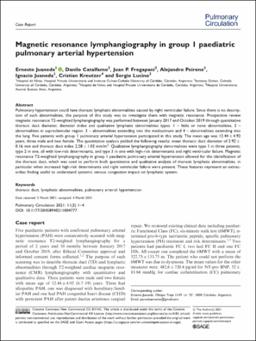Magnetic resonance lymphangiography in group 1 paediatric pulmonary arterial hypertension

View/
Date
2021-03Author
Kreutzer, Christian.
Juaneda, Ernesto.
Catalfamo, Danilo.
Et al.
Metadata
Show full item recordAbstract
Abstract
Pulmonary hypertension could have thoracic lymphatic abnormalities caused by right ventricular failure. Since there is no description of such abnormalities, the purpose of this study was to investigate them with magnetic resonance. Prospective review magnetic resonance T2-weighted lymphangiography was performed between January 2017 and October 2019 through quantitative thoracic duct diameter, diameter index and qualitative lymphatic abnormalities types: 1 - little or none abnormalities, 2 - abnormalities in supraclavicular region, 3 - abnormalities extending into the mediastinum and 4 - abnormalities extending into the lung. Five patients with group 1 pulmonary arterial hypertension participated in this study. The mean age was 12.44 ± 4.92 years, three male and two female. The quantitative analysis yielded the following results: mean thoracic duct diameter of 2.92 ± 0.16 mm and thoracic duct index 2.28 ± 1.03 mm/m2. Qualitative lymphangiography abnormalities were type 1 in three patients, type 2 in one, all with low-risk determinants, and type 3 in one with high-risk determinants and right ventricular failure. Magnetic resonance T2-weighted lymphangiography in group 1 paediatric pulmonary arterial hypertension allowed for the identification of the thoracic duct, which was used to perform both quantitative and qualitative analysis of thoracic lymphatic abnormalities, in particular when increased high-risk determinants and right ventricular failure were present. These features represent an extracardiac finding useful to understand systemic venous congestion impact on lymphatic system.
Keywords: thoracic duct, lymphatic abnormalities, pulmonary arterial hypertension.
© The Author(s) 2021.
Collections
The following license files are associated with this item:

